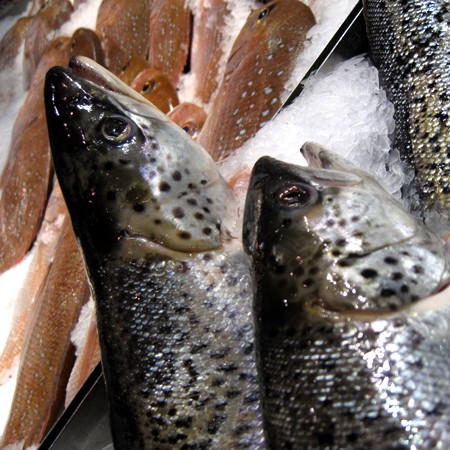Folks in the foodservice industry quickly learn how to judge the freshness of foods whether they are shopping in person or receiving shipments from suppliers. You can use the same freshness cues the pros do to ensure that you get the best food for your hard-earned bucks!
Fish
Look for clear, bulging eyes, moist by not slimy skin, an absence of fishy odours (should smell like fresh lake or sea water), firm moist flesh, and bright red (not brown)gills. If the fish you are looking at has had the its gills removed, it might be older than represented by the seller. Flesh should bounce back when pressed.
Seafood
These cues apply to clams, oysters, mussels, lobsters, shrimps, prawns, crawfish and crabs. Look for absence of any strong odour (should smell like sea water), no broken or cracked shells, no open shells (on clams, mussels or oysters). All seafood should arrive alive, on cracked ice.
Poultry
Look for no off colours or odours, tight skin, firm flesh. No excess fluids in the package.
Meat
Beef: Look for bright red colour; ‘clean’ white fat; moist, firm flesh.
Pork: Look for pink flesh, ‘clean’ white fat; moist, firm flesh.
Lamb: Look for light red/deep pink colour (grain fed may be lighter and less pink); ‘clean’ white fat; moist, firm flesh.
For all of the above, make sure there is no excess fluid in the package.
Eggs
Look for clean, uncracked shells with no dark spots which could indicate shell weakness. Though you can’t do this in the store, when you open an egg, look for firm, bright yellow yolks, and whites that are firm and cling to the yolk. Totally gone eggs usually have a slight (or pronounced) odour of sulphur dioxide – rotten eggs gas!
Dairy
Only pasteurized milk products are allowed to be sold in most Canadian and US markets. No worry about bacterial contamination. But make sure all containers are sealed and undamaged. Bad milk products will be curdled and separated, and smell sour.
Produce
Look for whole, clean, unblemished, undamaged veggies and fruits. Colours should be bright, and correct for the item. Greens should be moist and crisp. Hard fruits and veggies should be firm and heavy for their size, indicating full hydration. Wilting, discolouration and mould spots call for outright rejection.
Frozen Foods
Packaging must be intact. Ideally, items should be Individually Quick Frozen (IQF) showing a minimum of surface frost. If you buy frozen foods, make sure they stay good and frozen on the way home to your freezer.
Cryovac (Vacuum Packed) Foods
Vacuum packaging is most commonly used for frozen produce and meat, as well as for pre-made frozen dinners and sides. Often referred to as ‘cryovac’ packaging, after the pioneer of the process, this style of packaging vacuum seals fresh foods in heavy plastic, under a vacuum. For long term storage, the resulting vacuum packs are usually frozen. Think of the New Zealand Spring Lamb you often see in your supermarket’s freezer section. Sometimes, you’ll find cryovac packs that are not frozen. They’re probably still just fine. Don’t be put off any any purplish liquid inside the package. That turns red (or should) as soon as you break the seal and let it breathe fresh air. Any slightly off odours should also dissipate quickly once the package is opened.
Supermarket Packages
How do you know what you’re getting if the meat you’re looking at is already sealed inside plastic wrap, on a styrofoam tray?
You can still use visual cues such as colour and judge firmness with a fingertip touch.
And you’ll easily see if there are excess fluids in the package. In fact, supermarkets routinely pack their foam-trayed cuts with little absorbent pads under the meat to minimize visible fluids in the package. So if you see any at all, it night be a bad sign.
There are other things you need to know about how supermarkets package their plastic-and-foam wrapped meats. But that’s for a future instalment of Cooking 101!
~ Maggie J.


